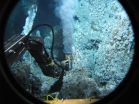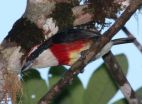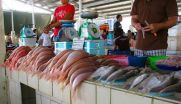(Press-News.org) AMHERST, Mass. – By some estimates, a third of the Earth's organisms by mass live in our planet's rocks and sediments, yet their lives and ecology are almost a complete mystery. This week, microbiologist James Holden at the University of Massachusetts Amherst and others report in Proceedings of the National Academy of Sciences the first detailed data about a group of methane-exhaling microbes that live deep in the cracks of hot undersea volcanoes.
Holden says, "Evidence has built over the past 20 years that there's an incredible amount of biomass in the Earth's subsurface, in the crust and marine sediments, perhaps as much as all the plants and animals on the surface. We're interested in the microbes in the deep rock, and the best place to study them is at hydrothermal vents at undersea volcanoes. Warm water flows bring the nutrient and energy sources they need."
"Just as biologists studied the different habitats and life requirements for giraffes and penguins when they were new to science, for the first time we're studying these subsurface microorganisms, defining their habitat requirements and determining how those differ among species. It's very exciting, and will advance our understanding of biogeochemical cycles in the deep ocean."
The study also addresses such questions as what metabolic processes may have looked like on Earth 3 billion years ago and what alien microbial life might look like on other planets. Further, because the study involves methanogens, microbes that inhale hydrogen and carbon dioxide to produce methane as waste, it may also shed light on terrestrial natural gas formation.
One major goal was to test results of predictive computer models and establish the first environmental hydrogen threshold for hyperthermophilic (super-heat-loving) methanogenic (methane-producing) microbes in hydrothermal fluids. "Models have predicted the habitability of the rocky environments that we're most interested in, but we wanted to ground truth into these models and refine them," Holden explains.
In a 2-liter bioreactor at UMass Amherst where she could control hydrogen levels, graduate student Helene Ver Eecke grew pure cultures of hyperthermophilic methanogens from their study site alongside a commercially available hyperthermophilic methanogen species as a control. She found growth kinetics for the three organisms were about the same. That is, all grew at the same rate when given equal amounts of hydrogen and had the same minimum growth requirements. "These experiments established for the first time that these methanogens need at least 17 micromolar of hydrogen to grow," Holden says.
Investigators from several institutions brought an unusually rich mix of expertise to this work. Holden and Ver Eecke at UMass Amherst used culturing techniques to look for organisms in nature and then study their growth kinetics in the lab. Co-investigators Julie Huber at the Marine Biological Laboratory on Cape Cod provided molecular analyses of the microbes while David Butterfield and Marvin Lilley at the University of Washington contributed geochemical fluid analyses.
Using the research submarine Alvin, they collected samples of hydrothermal fluids flowing from black smokers up to 350 degrees C (662 degrees F) and seeping out of ocean floor cracks at lower temperatures. Samples were from Axial Volcano and the Endeavour Segment, both long-term observatory sites along an undersea mountain range about 200 miles off the coast of Washington and Oregon and 1-1.5 miles below the surface.
"We use specialized sampling instruments to measure both the chemical and microbial composition of hydrothermal fluids," says Butterfield. "This is an effort to understand the biological and chemical factors that determine microbial community structure and growth rates." At the Axial site, they found hydrogen above their methanogen threshold for growth and molecular, organismal and geochemical evidence of on-going methanogenesis, while at Endeavour hydrogen levels were below their threshold and evidence for methanogenesis was largely absent. Others have taken culture and fluid samples around the world, so Holden and colleagues analyzed these as well and confirmed the lower threshold of hydrogen concentration needed by these methanogens.
There was a final happy twist awaiting the researchers as they pieced together a picture of how these methanogens live and work. At the low-hydrogen Endeavour site, they found that a few hyperthermophilic methanogens can eke out a living by feeding on the hydrogen waste produced by other hyperthermophiles.
"This was extremely exciting," says Holden. "We hypothesized that the methanogens grow syntrophically with the hydrogen producing microbes, and it worked out that way in the lab with a strain from the site. So we have described a methanogen ecosystem that includes a symbiotic relationship between microbes, which in my mind highlights the strength of our multi-pronged team approach. It really paid off. We feel that more research coupling broad field measurements with laboratory experiments will be really fruitful in the future."
INFORMATION:
Support for this research was from the National Science Foundation, NASA Astrobiology Institute, and the National Oceanographic and Atmospheric Administration.
UMass Amherst, national team define limits of microbial life in an undersea volcano
A third of Earth's organisms by mass live in rock and sediments, yet their lives and ecology are a mystery - This week, a report in PNAS offers the first detailed data about a group of methane-exhaling microbes in undersea volcanoes
2012-08-07
ELSE PRESS RELEASES FROM THIS DATE:
Possible muscle disease therapeutic target found
2012-08-07
Baltimore, MD — The study of muscular system protein myostatin has been of great interest to researchers as a potential therapeutic target for people with muscular disorders. Although much is known about how myostatin affects muscle growth, there has been disagreement about what types of muscle cells it acts upon. New research from a team including Carnegie's Chen-Ming Fan and Christoph Lepper narrows down the field to one likely type of cell. Their work is published the week of August 6 by Proceedings of the National Academy of Sciences.
Myostatin is known to inhibit ...
New bird species discovered in 'cloud forest' of Peru
2012-08-07
ITHACA, N.Y. – A colorful, fruit-eating bird with a black mask, pale belly and scarlet breast – never before described by science – has been discovered and named by Cornell University graduates following an expedition to the remote Peruvian Andes.
The Sira Barbet, Capito fitzpatricki, is described in a paper published in the July 2012 issue of The Auk, the official publication of the American Ornithologists' Union.
The new species was discovered during a 2008 expedition led by Michael G. Harvey, Glenn Seeholzer and Ben Winger, young ornithologists who had recently graduated ...
UC San Diego team aims to broaden researcher access to protein simulation
2012-08-07
Using just an upgraded desktop computer equipped with a relatively inexpensive graphics processing card, a team of computer scientists and biochemists at the University of California, San Diego, has developed advanced GPU accelerated software and demonstrated for the first time that this approach can sample biological events that occur on the millisecond timescale.
These results have the potential to bring millisecond scale sampling, now available only on a multi-million dollar supercomputer, to all researchers, and could significantly impact the study of protein dynamics ...
Investing in quality of care for diabetic patients reduces costs
2012-08-07
MINNEAPOLIS (August 6, 2012) – University of Minnesota School of Public Health researchers have found that medical group practices can reduce costs for patients with diabetes by investing in improved quality of care.
In the study, which appears in the August issue of Health Affairs, University of Minnesota researchers analyzed 234 medical group practices providing care for more than 133,000 diabetic patients. After developing a "quality of care" score based on select patient care initiatives, researchers found that medical providers saved an average of $51 in health ...
US-born Latinas at great risk of having babies with retinoblastoma
2012-08-07
In a large epidemiologic study, researchers at UCLA's Jonsson Cancer Center found that the children of U.S.-born Latina women are at higher risk of having retinoblastoma, a malignant tumor of the retina which typically occurs in children under six.
The study, which focused on babies born in California, also found that offspring of older fathers were at greater risk for retinoblastoma, as were children born to women with sexually transmitted diseases and those born in multiple births, which may indicate an increased risk from in vitro fertilization. Those findings confirmed ...
Seafood, wild or farmed? The answer may be both
2012-08-07
(Santa Barbara, Calif.) –– Most people think of seafood as either wild or farmed, but in fact both categories may apply to the fish you pick up from your grocery store. In recent years, for example, as much as 40 percent of the Alaskan salmon catch originated in fish hatcheries, although it may be labeled "all wild, never farmed."
An article produced by a working group of UC Santa Barbara's National Center for Ecological Analysis and Synthesis (NCEAS) recommends that when a combination of seafood production techniques are used, this be acknowledged in the marketplace. ...
Preschool children who can pay attention more likely to finish college
2012-08-07
CORVALLIS, Ore. – Young children who are able to pay attention and persist on a task have a 50 percent greater chance of completing college, according to a new study at Oregon State University.
Tracking a group of 430 preschool-age children, the study gives compelling evidence that social and behavioral skills, such as paying attention, following directions and completing a task may be even more crucial than academic abilities.
And the good news for parents and educators, the researchers said, is that attention and persistence skills are malleable and can be taught.
The ...
Critically ill uninsured Americans still at risk of being turned away from hospitals despite law
2012-08-07
Despite a twenty-five year old law that bans "patient dumping" the practice continues to put uninsured Americans at risk, according to a national team of researchers led by a professor at the George Washington School of Public Health and Health Services. Patient dumping is the practice of turning away or transferring uninsured patients with emergency medical conditions.
The study, which appears in the August issue of Health Affairs, suggests that hospitals still practice "patient dumping" which is in violation of the law. The researchers investigate and present five ...
New research studies policy divergence, voter polarization in elections
2012-08-07
CHAMPAIGN, Ill. — A study from University of Illinois economics professors demonstrates a new method to analyze the relationships among voters' issue preferences, the candidates' policy positions and voter behavior.
Estimating the distribution of voter preferences and the extent of policy divergence between the candidates' platforms, economics professors Stefan Krasa and Mattias Polborn are able to separate observed changes in voter behavior into those driven by voter radicalization versus those caused by increased policy differences between the two parties.
"We have ...
Poorest Americans at risk if states opt out of Medicaid expansion
2012-08-07
Health coverage for the poorest Americans could be in jeopardy in many states as a result of the U.S. Supreme Court's ruling last month on the Affordable Care Act, according to a new legal analysis. The report examines federal and state Medicaid options following the United States Supreme Court's ruling in NFIB v Sebelius and appears in the August issue of the journal Health Affairs.
"Some states will use the court's decision as an excuse to delay or refuse to participate in the expansion of Medicaid as outlined in the Affordable Care Act," says lead author of the report, ...
LAST 30 PRESS RELEASES:
URI researchers uncover molecular mechanisms behind speciation in corals
Chitin based carbon aerogel offers a cleaner way to store thermal energy
Tracing hidden sources of nitrate pollution in rapidly changing rural urban landscapes
Viruses on plastic pollution may quietly accelerate the spread of antibiotic resistance
Three UH Rainbow Babies & Children’s faculty elected to prestigious American Pediatric Society
Tunnel resilience models unveiled to aid post-earthquake recovery
Satellite communication systems: the future of 5G/6G connectivity
Space computing power networks: a new frontier for satellite technologies
Experiments advance potential of protein that makes hydrogen sulfide as a therapeutic target for Alzheimer’s disease
Examining private equity’s role in fertility care
Current Molecular Pharmacology achieves a landmark: real-time CiteScore advances to 7.2
Skeletal muscle epigenetic clocks developed using postmortem tissue from an Asian population
Estimating unemployment rates with social media data
Climate policies can backfire by eroding “green” values, study finds
Too much screen time too soon? A*STAR study links infant screen exposure to brain changes and teen anxiety
Global psychiatry mourns Professor Dan Stein, visionary who transformed mental health science across Africa and beyond
KIST develops eco-friendly palladium recovery technology to safeguard resource security
Statins significantly reduce mortality risk for adults with diabetes, regardless of cardiovascular risk
Brain immune cells may drive more damage in females than males with Alzheimer’s
Evidence-based recommendations empower clinicians to manage epilepsy in pregnancy
Fungus turns bark beetles’ defenses against them
There are new antivirals being tested for herpesviruses. Scientists now know how they work
CDI scientist, colleagues author review of global burden of fungus Candida auris
How does stroke influence speech comprehension?
B cells transiently unlock their plasticity, risking lymphoma development
Advanced AI dodel predicts spoken language outcomes in deaf children after cochlear implants
Multimodal imaging-based cerebral blood flow prediction model development in simulated microgravity
Accelerated streaming subgraph matching framework is faster, more robust, and scalable
Gestational diabetes rose every year in the US since 2016
OHSU researchers find breast cancer drug boosts leukemia treatment
[Press-News.org] UMass Amherst, national team define limits of microbial life in an undersea volcanoA third of Earth's organisms by mass live in rock and sediments, yet their lives and ecology are a mystery - This week, a report in PNAS offers the first detailed data about a group of methane-exhaling microbes in undersea volcanoes



